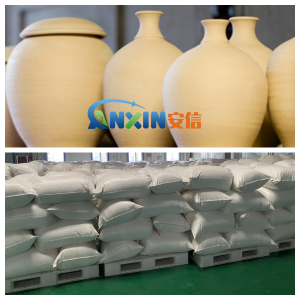Carboxymethyl cellulose (CMC) is an important water-soluble polymer compound with excellent thickening, dispersing, bonding, and film-forming properties. It is widely used in the ceramic industry in pulping, molding, glazing, and printing. As a highly effective organic additive, CMC not only improves the rheological properties of ceramic bodies and glaze slurries, but also significantly enhances the mechanical strength and appearance of the products, making it irreplaceable in modern ceramic production.
1. During the slurrying and molding stages of ceramic bodies, CMC primarily acts as a dispersant and thickener. It effectively disperses solid particles within the body, maintaining a uniform and stable slurry and preventing sedimentation and agglomeration. The carboxymethyl groups in the CMC molecule form stable hydrogen bonds with water molecules, increasing the viscosity and flow control of the slurry, thereby ensuring smoother flow during the casting, extrusion, and roller-forming processes. Furthermore, CMC exhibits excellent water retention, preventing cracking and deformation during the drying process, ensuring a dense and dimensionally stable body.
2. In the ceramic glaze slurry preparation and glazing process, CMC plays a crucial role as a suspending agent and binder. The addition of CMC significantly increases the glaze slurry viscosity, allowing the glaze to form a uniform, fine coating on the body surface, preventing sagging, cracking, or flaking. Due to its excellent film-forming properties, CMC forms a flexible organic film between the body and the glaze, enhancing the bond between the two and reducing glaze surface defects during firing. CMC also improves the storage stability of the glaze, preventing delamination or sedimentation caused by prolonged storage, thereby enhancing production continuity and controllability.
3. In ceramic printing and glaze printing, CMC is often used to prepare printing gels or screen printing ink systems. It provides appropriate rheological properties, enabling the printing material to pass smoothly through the screen and adhere precisely to the body surface during the screen printing process, ensuring sharp edges and uniform color. Furthermore, CMC exhibits excellent heat resistance and flammability, completely decomposing during firing, leaving no carbon residue or affecting the glaze gloss, thereby ensuring the final product’s aesthetic quality.
4. Regarding high-temperature firing and finished product performance, although CMC decomposes and volatilizes during firing, the bonding force it provides during the green body drying phase significantly enhances green body strength and reduces breakage during handling and processing. The appropriate addition of CMC can also improve green body density and crack resistance, positively impacting the mechanical strength and surface smoothness of the sintered ceramic.
5. It is important to note that the dosage and type of CMC used in the ceramic industry need to be adjusted according to specific process requirements. Highly substituted CMC exhibits excellent solubility and rheological control capabilities, making it suitable for high-precision ceramics and high-end glaze systems; low-substituted CMC is more suitable for use in structural ceramics or household ceramic green body formulations. During use, the dissolution temperature, pH value, and stirring speed must be strictly controlled to ensure full dissolution and uniform dispersion of the CMC.
6. The practical application of CMC in the ceramic industry has demonstrated significant comprehensive benefits. It provides efficient technical support for ceramic production by improving green body fluidity, enhancing glaze slurry stability, increasing molding strength, and enhancing surface quality. As ceramic manufacturing develops towards high performance and environmental protection, CMC, as a green additive, will continue to expand its application potential in the ceramic field and play a greater role in improving the quality of ceramic products and production efficiency.
Post time: Oct-17-2025








